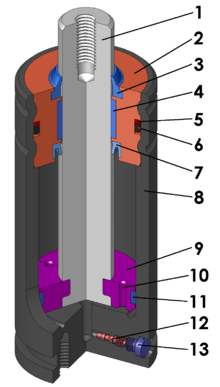WHAT IS THE GAS SPRING
A gas spring is a type of spring that, unlike a typical mechanical spring that relies on elastic deformation, uses compressed gas contained within an enclosed cylinder sealed by a sliding piston to pneumatically store potential energy and withstand external force applied parallel to the direction of the piston shaft.
Common applications include automobiles (where they are incorporated into the design of struts that support the weight of the hatchback tailgate while they are open) and office chairs. They are also used in furniture, medical and aerospace applications. Much larger gas springs are found in machines that are used in industrial manufacturing (the press tooling industry), where the forces they are required to exert often range from 2500N to 400,000N (forty tonnes).

Gas spring with sectional view:
2. Head cap
3. Piston rod wiper
4. Piston rod guide bushing
5. Retaining ring
6. O-ring
7. Piston rod seal
8. Cylinder
9. Piston
10. Flow-restriction orifice
11. Piston guide bushing
12. Valve
13. Valve-sealing screw
Types[edit]
Gas springs are manufactured in many varieties including:
Standard cylinder
Fixed-height cylinder
Spindle only
Cable cylinder
Stage cylinder
Non-rotating cylinder
Return cylinder (no height adjustment)
Auto-return cylinder with height adjustment
Bouncing cylinder
Dual-mode cylinder
Heavy duty cylinder
Oil damper







